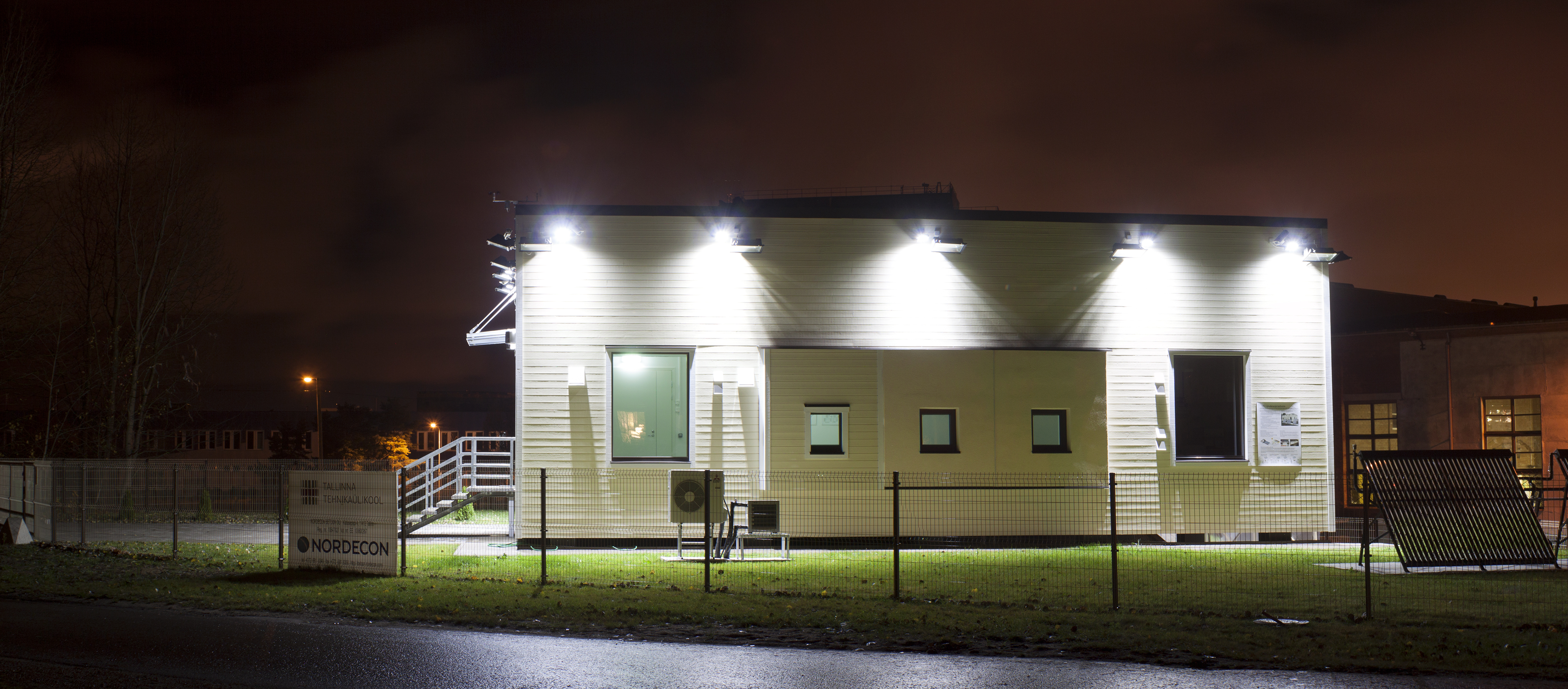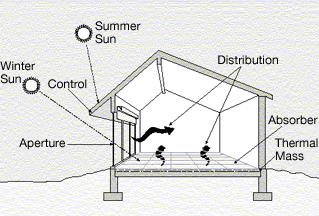|
Energy Neutral Design
An Energy Neutral Design is a Design of any type (Website, Multi-media, Architecture, Art, Music, Entertainment, etc.) that has the environment and low energy consumption practices in mind during all stages of planning and production. Energy neutral design can also refer to environmentally powered electronics, where devices absorb or harvest energy from their immediate surroundings (ex. light, heat, radio waves, motion) and transform it to the electricity they require for their operation. One example of this is the batteryless radio. Research specifically in Wireless Sensor Networks (WSNs) and Internet of Things (IoT) devices targets energy neutral design by taking miniature technologies and using ideas like data compression and non-continuous data transmission to reduce energy consumption. Examples *Zero-energy building *Energy efficiency in British housing *Carbon footprint *Low-carbon economy *Live Earth *Reverb Reverberation (also known as reverb), in acoustics, is a p ... [...More Info...] [...Related Items...] OR: [Wikipedia] [Google] [Baidu] |
Batteryless Radio
A batteryless radio is a radio receiver which does not require the use of a battery to provide it with electrical power. Originally this referred to units which could be used directly by AC mains supply (mains radio); it can also refer to units which do not require a power source at all, except for the power that they receive from radio waves. History The line-operated vacuum tube receiver was invented in 1925 by Edward S. Rogers, Sr. The unit operated with 5 Rogers AC vacuum tubes and the Rogers Battery-Eliminator Power Unit (power supply). This unit was later marketed for $120 as "Type 120". He established the Toronto station CFRB (an abbreviation of ''Canada's First Rogers Batteryless'') to promote sales of the product. Batteryless radios were not introduced into the United States until May 1926 and then into Europe in 1927. Crystal radio receivers are a very simple kind of batteryless radio receiver. They do not need a battery or power source, except for the power that ... [...More Info...] [...Related Items...] OR: [Wikipedia] [Google] [Baidu] |
Wireless Sensor Networks
Wireless sensor networks (WSNs) refer to networks of spatially dispersed and dedicated sensors that monitor and record the physical conditions of the environment and forward the collected data to a central location. WSNs can measure environmental conditions such as temperature, sound, pollution levels, humidity and wind. These are similar to wireless ad hoc networks in the sense that they rely on wireless connectivity and spontaneous formation of networks so that sensor data can be transported wirelessly. WSNs monitor physical conditions, such as temperature, sound, and pressure. Modern networks are bi-directional, both collecting data and enabling control of sensor activity. The development of these networks was motivated by military applications such as battlefield surveillance. Such networks are used in industrial and consumer applications, such as industrial process monitoring and control and machine health monitoring. A WSN is built of "nodes" – from a few to hundreds or th ... [...More Info...] [...Related Items...] OR: [Wikipedia] [Google] [Baidu] |
Internet Of Things
The Internet of things (IoT) describes physical objects (or groups of such objects) with sensors, processing ability, software and other technologies that connect and exchange data with other devices and systems over the Internet or other communications networks. Internet of things has been considered a misnomer because devices do not need to be connected to the public internet, they only need to be connected to a network and be individually addressable. The field has evolved due to the convergence of multiple technologies, including ubiquitous computing, commodity sensors, increasingly powerful embedded systems, as well as machine learning.Hu, J.; Niu, H.; Carrasco, J.; Lennox, B.; Arvin, F.,Fault-tolerant cooperative navigation of networked UAV swarms for forest fire monitoring Aerospace Science and Technology, 2022. Traditional fields of embedded systems, wireless sensor networks, control systems, automation (including Home automation, home and building automation), indepen ... [...More Info...] [...Related Items...] OR: [Wikipedia] [Google] [Baidu] |
Zero-energy Building
A Zero Energy Building (ZEB), also known as a Net Zero Energy (NZE) building, is a building with net zero energy consumption, meaning the total amount of energy used by the building on an annual basis is equal to the amount of renewable energy created on the site or in other definitions by renewable energy sources offsite, using technology such as heat pumps, high efficiency windows and insulation, and solar panels. The goal is that these buildings contribute less overall greenhouse gas to the atmosphere during operations than similar non-ZNE buildings. They do at times consume non-renewable energy and produce greenhouse gases, but at other times reduce energy consumption and greenhouse gas production elsewhere by the same amount. The development of zero-energy buildings is encouraged by the desire to have less of an impact on the environment, and by tax breaks and savings on energy costs that make zero-energy buildings financially viable. Terminology tends to vary between cou ... [...More Info...] [...Related Items...] OR: [Wikipedia] [Google] [Baidu] |
Energy Efficiency In British Housing
Domestic housing in the United Kingdom presents a possible opportunity for achieving the 20% overall cut in UK greenhouse gas emissions targeted by the Government for 2010. However, the process of achieving that drop is proving problematic given the very wide range of age and condition of the UK housing stock. Carbon emissions Although carbon emissions from housing have remained fairly stable since 1990 (due to the increase in household energy use having been compensated for by the 'dash for gas'), housing accounted for around 30% of all the UK's carbon dioxide emissions in 2004 (40 million tonnes of carbon) up from 26.42% in 1990 as a proportion of the UK's total emissions. The Select Committee on Environmental Audit noted that emissions from housing could constitute over 55% of the UK's target for carbon emissions in 2050. A 2006 report commissioned by British Gas estimated the average carbon emissions for housing in each of the local authorities in Great Britain, the first time ... [...More Info...] [...Related Items...] OR: [Wikipedia] [Google] [Baidu] |
Carbon Footprint
A carbon footprint is the total greenhouse gas (GHG) emissions caused by an individual, event, organization, service, place or product, expressed as carbon dioxide equivalent (CO2e). Greenhouse gases, including the carbon-containing gases carbon dioxide and methane, can be emitted through the burning of fossil fuels, land clearance, and the production and consumption of food, manufactured goods, materials, wood, roads, buildings, transportation and other services. In most cases, the total carbon footprint cannot be calculated exactly because of inadequate knowledge of data about the complex interactions between contributing processes, including the influence of natural processes that store or release carbon dioxide. For this reason, Wright, Kemp, and Williams proposed the following definition of a carbon footprint: The Greenhouse Gas Protocol has extended the range of gases. The global average annual carbon footprint per person in 2014 was about 5 tonnes CO2e. Although the ... [...More Info...] [...Related Items...] OR: [Wikipedia] [Google] [Baidu] |
Low-carbon Economy
A low-carbon economy (LCE) or decarbonised economy is an economy based on energy sources that produce low levels of greenhouse gas (GHG) emissions. GHG emissions due to human activity are the dominant cause of observed climate change since the mid-20th century. Continued emission of greenhouse gases will cause long-lasting changes around the world, increasing the likelihood of severe, pervasive, and irreversible effects for people and ecosystems. Shifting to a low-carbon economy on a global scale could bring substantial benefits both for developed and developing countries. Many countries around the world are designing and implementing low-emission development strategies (LEDS). These strategies seek to achieve social, economic, and environmental development goals while reducing long-term greenhouse gas emissions and increasing resilience to the effects of climate change. Globally implemented low-carbon economies are therefore proposed as a precursor to the more advanced, zero-ca ... [...More Info...] [...Related Items...] OR: [Wikipedia] [Google] [Baidu] |
Live Earth
Live Earth was an event developed to increase environmental awareness through entertainment. Background Founded by Emmy-winning producer Kevin Wall, in partnership with former U.S. Vice President Al Gore, ''Live Earth'' was built upon the belief that entertainment has the power to transcend social and cultural barriers to move the world community to action. Live Earth seeks to leverage the power of entertainment through integrated events, media, and the live experience to ignite a global movement aimed at solving the most critical environmental issues of our time. Live Earth 2007 The 1st series of benefit concerts were held on 7 July 2007. The concerts brought together more than 150 musical acts in eleven locations around the world and were broadcast to a mass global audience through television, radio, and live internet streams. Live Earth India 2008 The 2nd ''Live Earth'' concert was scheduled for 7 December 2008 at the ''Andheri Sports Complex'' on Veera Desai Road in Andh ... [...More Info...] [...Related Items...] OR: [Wikipedia] [Google] [Baidu] |
Reverb (non-profit)
Reverb is a non-profit environmental organization that aims to educate and engage musicians and their fans to promote environmental sustainability. It was founded by environmentalist Lauren Sullivan and her musician husband, Guster guitarist/vocalist Adam Gardner. The organization's services include carbon neutral concerts and venues, biodiesel for vehicles and generators, waste reduction, biodegradable catering products; recycling, green bus supplies and cleaners, energy efficiency, green contract rider, environmentally sustainable merchandise, green sponsorship, and educational outreach. Reverb provides learning experiences designed to engage volunteers with local nonprofit groups. Customers can also donate money for environmental causes and receive a sticker. The group has worked with artists including Drake, Jason Mraz, The Dead, Phish, Dave Matthews Band, John Mayer, Harry Styles, Guster, Barenaked Ladies, Maroon 5, and the Lilith Fair Lilith Fair was a concert ... [...More Info...] [...Related Items...] OR: [Wikipedia] [Google] [Baidu] |
Energy
In physics, energy (from Ancient Greek: ἐνέργεια, ''enérgeia'', “activity”) is the quantitative property that is transferred to a body or to a physical system, recognizable in the performance of work and in the form of heat and light. Energy is a conserved quantity—the law of conservation of energy states that energy can be converted in form, but not created or destroyed. The unit of measurement for energy in the International System of Units (SI) is the joule (J). Common forms of energy include the kinetic energy of a moving object, the potential energy stored by an object (for instance due to its position in a field), the elastic energy stored in a solid object, chemical energy associated with chemical reactions, the radiant energy carried by electromagnetic radiation, and the internal energy contained within a thermodynamic system. All living organisms constantly take in and release energy. Due to mass–energy equivalence, any object that has mass whe ... [...More Info...] [...Related Items...] OR: [Wikipedia] [Google] [Baidu] |
Energy Conservation
Energy conservation is the effort to reduce wasteful energy consumption by using fewer energy services. This can be done by using energy more effectively (using less energy for continuous service) or changing one's behavior to use less service (for example, by driving less). Energy conservation can be achieved through energy efficiency, which has a number of advantages, including a reduction in greenhouse gas emissions, a smaller carbon footprint, and cost, water, and energy savings. Energy conservation is an essential factor in building design and construction. It has increased in importance since the 1970s, as 40% of energy use in the U.S. is in buildings. Recently, concern over the effects of climate change and global warming has emphasized the importance of energy conservation. Energy can only be transformed from one form to another, such as when heat energy is converted into vehicle motive power or when water flow's kinetic energy is converted into electricity in hydroelectr ... [...More Info...] [...Related Items...] OR: [Wikipedia] [Google] [Baidu] |
.jpg)

.jpg)

